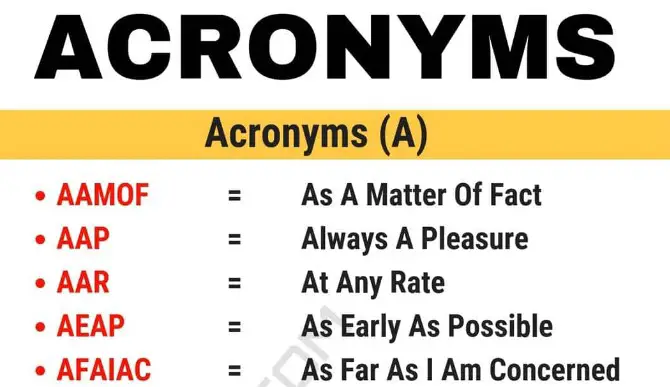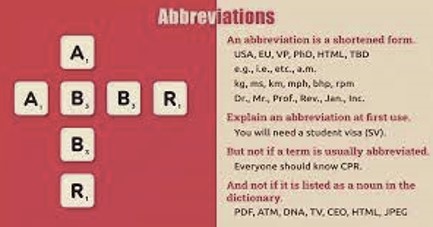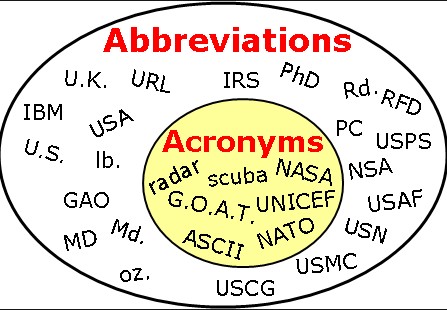In the vast landscape of the English language, two commonly encountered landmarks are acronyms and abbreviations. These linguistic shortcuts serve as efficient paths through the dense forest of words, enabling quicker communication and understanding. Their ubiquity across various forms of media, from texts and emails to professional documents, underscores their importance in modern communication.
The difference between an acronym and an abbreviation lies in their formation and usage. An acronym is a type of abbreviation formed from the initial letters of other words and pronounced as a word. In contrast, an abbreviation is a shortened form of a word or phrase, which may consist of a group of letters or just a part of the original word and is not necessarily pronounced as a separate word.
Despite their distinct definitions, acronyms and abbreviations both play a pivotal role in streamlining communication. They reduce the complexity and length of terms, making them easier to remember and faster to write. This linguistic efficiency is particularly valuable in professional, scientific, and technological contexts, where precision and brevity are paramount.

Defining Acronyms
Basic Definition
An acronym is a special kind of abbreviation. It’s made by taking the first letters of a phrase or group of words and combining them into a new word. This new word is then pronounced as it’s spelled, turning it into a handy shortcut. For instance, NASA stands for the National Aeronautics and Space Administration. Instead of saying or writing the full name, people just say “Nasa.”
Examples in Everyday Use
Acronyms are everywhere in our daily lives. Here are a few examples:
- LOL – Laugh Out Loud
- ASAP – As Soon As Possible
- PIN – Personal Identification Number
These acronyms have become so common that many people might not even remember what they stand for.
Origin and Evolution
The use of acronyms dates back to ancient times. Early examples include SPQR – Senatus Populusque Romanus, used in ancient Rome. However, the widespread use of acronyms as we know it today began in the 20th century, especially with the military and technological advancements. Over time, acronyms have evolved from formal communication shortcuts into integral parts of everyday language, including internet slang and texting language.
Defining Abbreviations
Basic Definition
An abbreviation is a shortened form of a word or phrase. Unlike acronyms, abbreviations might not form a new word. They’re like the quick sketches of language, capturing the essence of what they represent without the detail.
Common Types
Initialisms
Initialisms are a type of abbreviation where you say each letter individually. For example:
- FBI – Federal Bureau of Investigation
- ATM – Automated Teller Machine
Unlike acronyms, you don’t pronounce initialisms as words, but as a series of letters.
Truncations
Truncations are abbreviations where the end or part of a word is cut off. Examples include:
- Info for information
- Ad for advertisement
These are less formal and more likely to be used in casual conversation or writing.
Examples and Usage
Abbreviations, whether as initialisms or truncations, are pivotal in saving time and space. They are widely used in various fields such as science, where DNA (Deoxyribonucleic Acid) is preferred over the full term, or in everyday situations, where etc. (et cetera) concludes lists without having to name every item.
Key Differences
Formation Process
The formation process of acronyms and abbreviations sets them apart. Acronyms are formed by taking the initial letters of a phrase and pronouncing them as a word. Abbreviations, including initialisms and truncations, might not form a new word and include a broader range of shortening methods.
Pronunciation
Pronunciation is a clear differentiator. Acronyms are pronounced as words (NASA), while initialisms are spelled out (FBI). Truncations follow the pronunciation rules of the original word, just shortened (info).
Usage Contexts
The usage contexts also vary. Acronyms are often used when the new word is easier and quicker to say than the full term, making them popular in both professional and casual settings. Initialisms are preferred in formal or technical contexts where clarity is paramount. Truncations are mostly used in informal situations due to their casual nature.

Similarities
Purpose and Efficiency
Both acronyms and abbreviations serve the primary purpose of making communication more efficient. They shorten long phrases or names, making them easier to write and remember. This linguistic convenience is essential in fast-paced environments and digital communication, where brevity is highly valued.
Presence in Languages
Acronyms and abbreviations are not exclusive to English. Many languages incorporate these linguistic tools, adapting them to fit their unique phonetic and grammatical structures. This widespread presence highlights their universal utility in human communication.
Adaptation over Time
Language is ever-evolving, and so are acronyms and abbreviations. They adapt over time, reflecting changes in society, technology, and communication habits. Some become so ingrained in our language that they transition from being seen as shortcuts to becoming the primary terms for concepts or objects.
Usage Guidelines
Formal vs Informal Settings
The use of acronyms and abbreviations varies significantly between formal and informal settings. In formal documents or professional communications, it’s crucial to define an acronym or abbreviation upon its first use to ensure clarity. In contrast, informal settings, such as social media or text messaging, often see a more liberal and creative use of these linguistic shortcuts.
Industry-specific Applications
Different industries have developed their own sets of acronyms and abbreviations. For example, the medical field uses acronyms like CPR (Cardiopulmonary Resuscitation) extensively, while the tech industry might refer to UI (User Interface) frequently. Understanding these terms is essential for effective communication within those fields.
Common Misconceptions
One common misconception is that all abbreviations can be considered acronyms. This confusion underscores the importance of distinguishing between the two, as they serve different functions and follow different rules of usage.
Challenges and Mistakes
Common Errors
Mistakes often occur when people misuse acronyms or abbreviations, either by spelling them incorrectly, using them in inappropriate contexts, or misunderstanding their meanings. Such errors can lead to confusion and miscommunication.
Avoiding Ambiguity
To avoid ambiguity, it’s advisable to use acronyms and abbreviations judiciously. They should only be used when they are widely recognized or have been clearly defined in the communication. This clarity is particularly important in formal or professional settings.
Correcting Misuse
Correcting the misuse of acronyms and abbreviations involves a gentle approach, providing the correct usage or definition in context. Educating others about the proper use of these linguistic tools can help improve communication and understanding.
Impact on Language
Linguistic Evolution
Acronyms and abbreviations have played a significant role in the linguistic evolution, reflecting societal changes and technological advancements. They demonstrate how language adapts to meet the needs of efficiency, convenience, and innovation.
Influence on Digital Communication
In the realm of digital communication, acronyms and abbreviations are indispensable. They facilitate faster and more efficient text-based communication, fitting perfectly with the brevity and immediacy that digital platforms demand. Terms like BRB (Be Right Back) and FYI (For Your Information) have become staples in online and texting dialogues.
Role in Professional Jargon
Within professional jargon, acronyms and abbreviations serve to streamline complex terminologies, making them accessible to those within the field. They also foster a sense of community and shared knowledge among professionals. However, it’s crucial for experts to bridge the communication gap with those outside their field by minimizing jargon or explaining it clearly.
FAQs
What is an acronym?
An acronym is a type of abbreviation created from the initial letters of a phrase or a group of words, where the letters are combined to form a new word that is spoken phonetically. Examples include NASA (National Aeronautics and Space Administration) and RADAR (Radio Detection and Ranging). Acronyms simplify communication by condensing lengthy phrases into manageable, memorable words.
How do abbreviations differ from acronyms?
Abbreviations are shortened forms of words or phrases, used to save time and space. They can be created in various ways, including truncating a part of the word or using the initial letters of multiple words. Unlike acronyms, abbreviations may not always form a new word that can be pronounced phonetically. For instance, “Dr.” for Doctor and “etc.” for et cetera are abbreviations but not acronyms.
When should I use an acronym or abbreviation?
Use an acronym or abbreviation when you need to frequently reference a long term or phrase in your writing, especially if the term is well-known and widely accepted in your audience’s context. Acronyms are best used when the new word formed is easier to remember and pronounce than the original phrase. Abbreviations are suitable for both formal and informal contexts, but it’s crucial to ensure that your audience is familiar with them to avoid confusion.
Are acronyms always capitalized?
Acronyms are typically capitalized to highlight that each letter represents a separate word in the original phrase. However, there are exceptions, especially when the acronym becomes a commonly used word in its own right, such as “laser” (originally an acronym for Light Amplification by Stimulated Emission of Radiation). In such cases, the acronym might be written in lowercase.
Conclusion
Understanding the nuances between acronyms and abbreviations enriches one’s mastery of language, facilitating clearer and more effective communication. These linguistic tools not only streamline conversations and texts but also reflect the dynamic nature of language as it evolves to meet the demands of efficiency and clarity.
In the vast expanse of language, acronyms and abbreviations serve as essential navigational aids, guiding us through complex information with ease. Their correct usage empowers us to convey ideas succinctly and accurately, a crucial skill in the information-rich environment of the modern world. As language continues to adapt and grow, so too will our reliance on these convenient linguistic shortcuts.

